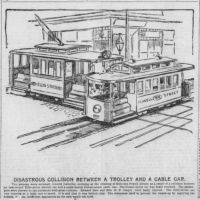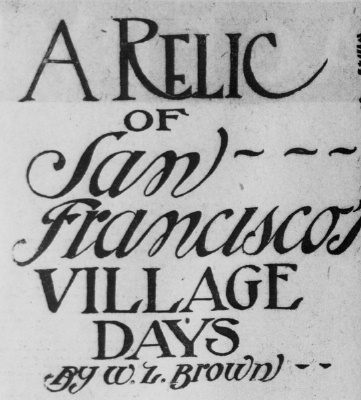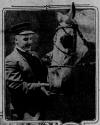| Where Should I Go from Here? Visit the Map |

|
San Francisco's Transportation Octopus, the Market Street Railway of 1893, a new book by Emiliano Echeverria, Michael Dolgushkin and Walter Rice, is now available as an Ebook on a DVD. I have written a small review. |

|

|
Presented by Emiliano Echeverria Thanks to Emiliano Echeverria for letting me present a series of photos that were hand-colored by Charles Smallwood |

|

|
A Market Street Cable Railway ad from about 1885 describes its different lines and its connection to Ocean Beach via the Park and Ocean Railroad. Val Lupiz Collection. All rights reserved. |

|
URR California-type cable car, probably on the Valencia Street line, before 1906. The United Railroads of San Francisco succeeded the Market Street Cable Railway Photograph courtesy of the Museum of the City of San Francisco. Oct, 1998 Picture of the Month. |

|
Market Street Cable Railway open car before 1906 (Source: "Market Street Railway Company, Past, Present and Future", San Francisco News Letter, Sep 1925). Oct, 1997 Picture of the Month. |
line: Market/Valencia (Blue Line)
opened: 22-Aug-1883. Market Street from East (now Embarcadero) at Ferry Building to Valencia, Valencia to Mission.
powerhouse: Market & Valencia
grip: Root single jaw side grip, lever-operated
gauge: 4'8 1/2"
cars: single-ended California cars (130 passenger capacity), and open cars.
turntables: double track, powered.
crossings:
| Intersection | Company | Status |
|---|---|---|
| Market/Larkin | SSR | superior |
| Market/Polk | ORR | superior |

|
A special Washburn and Moen wagon hauls a new cable for the McAllister Street cable car line out Golden Gate Avenue near Jefferson Square. (Source: San Francisco Public Library, San Francisco Historical Photograph Collection, AAC-7904). |
line: Market/McAllister (Yellow Line)
opened: late 1883. Market Street from East (now Embarcadero) at Ferry Building to McAllister, McAllister to Central, private right of way across block containing powerhouse & car barn to Masonic, Fulton to Stanyan at Golden Gate Park.
extended: 1892 on Fulton to turntable between 7th & 8th. This put the line in position for the 1894 Midwinter Fair.
extended: 1902 on Fulton to turntable at 12th, near the Chutes amusement park
powerhouse: McAllister & Masonic
grip: same as main line
gauge: same as main line
cars: same as main line.
turntables: double track, powered.
crossings:
| Intersection | Company | Status |
|---|---|---|
| Market/Larkin | SSR | superior |
| Market/Polk | ORR | superior |
| McAllister/Broderick | ORR | superior |
line: Market/Haight (Red Line)
opened: late 1883. Market Street from East (now Embarcadero) at Ferry Building to Haight, Haight to Stanyan at Golden Gate Park.
powerhouse: same as main line
grip: same as main line
gauge: same as main line
cars: same as main line.
turntables: double track, powered.
crossings:
| Intersection | Company | Status |
|---|---|---|
| Market/Larkin | SSR | superior |
| Market/Polk | ORR | superior |
line: Market/Hayes (Green Line)
opened: 26-May-1886. Market Street from East (now Embarcadero) at Ferry Building to Hayes, Hayes to Stanyan at Golden Gate Park.
powerhouse: Hayes and Masonic. Converted from steam to electric drive in 1904. Thank you to Emiliano Echeverria for the information.
grip: same as main line
gauge: same as main line
cars: same as main line.
turntables: double track, powered.
crossings:
| Intersection | Company | Status |
|---|---|---|
| Market/Larkin | SSR | superior |
| Market/Polk | ORR | superior |
| Hayes/Broderick | ORR | superior |
line: Market/Castro (White Line)
opened: 27-February-1888. Market Street from East (now Embarcadero) at Ferry Building to Castro, Castro to 26th Street.
powerhouse: (after 1906) Castro & Jersey.
grip: same as main line
grip: (after 1906) According to Richard Schlaich:
After the fire (1906) the Castro Line had a double (jaw) side grip. Having a single grip with a link bar (...) Castro had to be able to grip on both East and West side. Single end cars did not have this trouble, since these cars could turn around, and always used the right side of the single grip. So Castro had a left side jaw added.
gauge: same as main line
cars: (after 1906) double-ended "California cars" rebuilt from single-ended cars.
turntables: (after 1906). Crossover at 18th & Castro. Single track turntable at 26th & Castro, after 1906 used to switch cars from one track to the other.
crossings:
| Intersection | Company | Status |
|---|---|---|
| Market/Larkin | SSR | superior |
| Market/Polk | ORR | superior |
notes: MSR was the first large-scale cable railway system. It served San Francisco's main street, Market, and pushed service out into South of Market and Western Addition neighborhoods that earlier lines had not served.
MSR was owned by the same people as the Southern Pacific Railroad. It was often referred to as the "Southern Pacific Line".
The corporate history of the Market Street Cable Railway is complicated. The Market Street Railroad Company opened as a steam dummy line which ran on Market from Third and Kearney to Valencia, and Valencia to Mission on 04-Jul-1860. Public complaints caused the company to replace steam dummies with horses 06-Mar-1867. Read about the company's steam operations in "When Steam Ran on The Streets of San Francisco, Part II," by Walter Rice and Emiliano Echeverria.
The Southern Pacific Railroad formed the Market Street Railway on 22-Aug-1893, combining all the cable car operating companies in the city except Sutter, California, Geary, and the Presidio & Ferries. It also included the Metropolitan Railroad, the second electric line in San Francisco. On 08-Mar-1902, the United Railroads of San Francisco (URR) took over the Market Street Railway and the Sutter Street Railway. It also took over the San Francisco & San Mateo Railway, the first electric line in the city.

|
The Market Street Railway manufactured its own wire ropes at the Market and Valencia powerhouse using this scary-looking piece of machinery. (Source: San Francisco, the Birthplace of the Cable Railway, by Charles B Fairchild, The Street Railway Journal, June, 1893) May, 2021 Picture of the Month. |

|
Read an 1897 article about a collision between a Powell Street cable car and an Ellis Street electric car, both operated by the Market Street Railroad: Collision at Ellis and Powell. June, 2022 Picture of the Month. |

|
Read an 1897 article about a collision between a Sutter Street cable car and a Fillmore Street electric car: Collision at Sutter and Fillmore (from the San Francisco Chronicle). July, 2022 Picture of the Month. |

|
Read another 1897 article about the same collision between a Sutter Street cable car and a Fillmore Street electric car: Collision at Sutter and Fillmore (from the San Francisco Examiner). July, 2022 Picture of the Month. |

|
Read an article about a 1902 collision between a California Street Cable RailroadJones Street shuttle cable car and a Market Street Railway/United Railroads of San Francisco Ellis Street electric car: FOUR PERSONS ARE SEVERELY INJURED IN DOUBLE COLLISION AND CARS OF ELLIS AND JONES STREET ARE DAMAGED. January, 2018 Picture of the Month. |

|
Read a 31-May-1903 newspaper article about a collision between a Fillmore Street electric car and a Haight Street cable car. |

|
Read an 11-March-1906 newspaper article about Michael Houlihan, who drove the URR's franchise-protecting horse car line on California. |

|
Read an 04-June-1913 newspaper article about the last horse car to run in San Francisco in regular service. |
URR ran into financial difficulties and was reorganized as the Market Street Railway (again) on 01-Apr-1921. The Market Street Railway survived as an independent company until 29-Sep-1944, when it was taken over by the San Francisco Municipal Railway.
There is a railfan organization known as the Market Street Railway which promoted the new F Market Street line and organizes occasional electric rail festivals.
Only the Castro Street line had severe grades, so the Market Street system would have been electrified before the earthquake and fire of 18-Apr-1906 if the city had not been opposed to overhead wires on Market Street. The company seized the opportunity to erect "temporary" wires (which are still there) and inaugurate streetcar service on Market Street on 06-May-1906.
The McAllister line was replaced by the 5 McAllister streetcar line, which in turn was replaced by the present 5 Fulton trolley bus line. The McAllister powerhouse became a streetcar barn, which was used until 1948. The site is now a shopping center.
The initial conversion of the McAllister Street line to electric traction was not universally popular. Here is a San Francisco Chronicle article about a demand to restore cable traction:
The Haight line connected with the Park and Ocean Railway, a steam line which ran along H Street (now Lincoln Way) and across the end of Golden Gate Park on private right of way to the Seal Rock area. John F Kennedy Drive enters the park over an overpass above the right of way. The right of way is being restored as a hiking trail. The cable and steam lines were replaced by the 7 Haight streetcar line, which in turn was replaced by the 7 Haight trolley bus line, which did not go to the beach. The 7 Haight trolley bus line survived until Muni's massive service cuts on 05-December-2009. Read about the Park and Ocean Railway in "When Steam Ran on The Streets of San Francisco, Part I," by Walter Rice and Emiliano Echeverria.
The Hayes line was replaced by the 21 Hayes streetcar line, which in turn was replaced by the present 21 Hayes trolley bus line.
The initial conversion of the Hayes Street line to electric traction was not successful. Here is a San Francisco Chronicle article about problems faced by the converted line:
The Market Street portion of the Castro line was replaced by the 8 Market streetcar line, which in turn was replaced by the 8 Market trolley bus line, which in its turn was replaced by the F Market streetcar line in 1996.
The Valencia Street line was by the 26-Guerrero streetcar line, which in turn was replaced by the 26-Valencia motor coach line. The 26-Valencia survived until Muni's massive service cuts on 05-December-2009.
The Castro Street hill portion of the line was restored. It operated until 05-Apr-1941, when it was replaced, along with the Fillmore Hill counterbalance line, and the 24 Divisadero streetcar line, by the 24 Castro-Divisadero-Fillmore Hill motor coach line. The Castro Street Hill is now served by the 24-Divisadero trolley coach and the Fillmore Hill by 22 Fillmore trolley coach line.
Read "Market Street Railway's Efforts to Curtail Its Cable Car System", two contemporary newspaper articles about the Market Street Railway's struggle to abandon the Castro line and the Sacramento/Clay line of the former Ferries & Cliff House Railway, with an introduction by Walter Rice
Market Street Railway tested air-operated grips and brakes on the Castro line in the 1920's. The grips squeezed the cable too hard.

|
Market Street cable car 133 sits on Castro Street on 08-May-1941, waiting to be towed to the scrapper. Wayne Miller Collection. All rights reserved. December, 2006 Picture of the Month. |
The Market Street Railway preserved Castro Street cable car 133 in original condition until 08-May-1941, when it was scrapped because of a lack of storage space. That was a great loss.
There is an amazing film called "A Trip Down Market Street" taken in 1905 from the front of a cable car running down Market Street towards the Ferry Building. It makes one appreciate current traffic laws. Read an article about what may have been its world premiere.

|
| Frames from "A Trip Down Market Street (source: Library of Congress). No Thumbnail. |
The Market Street Cable Railway's slot down the middle of Market street marked a dividing line between the working class "South of the Slot" and the middle class north side of Market. I remember older people using the term "South of the Slot". Jack London's story "South of the Slot" describes the contrasting sides of the city.
Vist my More Market Street Pictures page for more interesting pictures of the Market Street Cable Railway and its successors.

|
Market Street Cable Railway cars at turntable in front of the Old Ferry Building, before 1895 (Source: The Barbary MUSH Photo Archive). |
from Poor's Directory of Railway Officials, 1887P. 233 Market Street (Cable) Railway Co. operates 18.5 miles of double track road, owns 86 horses, 2 dummy engines, 182 cars and 12 other vehicles. Directors, Leland Stanford, Chas. F. Crocker, Timothy Hopkins, N. T. Smith, J. L. Willcut, San Francisco, Cal -- Leland Stanford, Pres., Chas. F. Crocker, Vice-Pres., J. L. Willcut, Sec., N. T. Smith, Treas., H. D. Morton, Supt.& Pur. Agt.. -- GENERAL OFFICE, Fourth & Townsend Sts., San Francisco, Cal. |
Hello Central, Give Me the URRHere is the United Railroads of San Francisco's extensive listing in the February, 1903 Pacific States Telephone and Telegraph Company San Francisco phone directory: Priv. Exch 314. United Railroads of San Francisco, Rialto Bldg.
Dedicated volunteers at San Francisco Genealogy typed in every page of the book. |
San Francisco's Transportation Octopus, the Market Street Railway of 1893
by Emiliano Echeverria, Michael Dolgushkin and Walter Rice

|
The front cover. December, 2017 Picture of the Month. |
San Francisco's Transportation Octopus, the Market Street Railway of 1893, a new book by Emiliano Echeverria, Michael Dolgushkin and Walter Rice, is now available as an Ebook on a DVD.

|
When you open the disc, you see the 19 pdf files it contains. Each file contains a chapter, a part of a longer chapter or another section of the book. When you double click on a file, it opens in your default pdf reader.
Book One (Chapters 1-6) is "The History of the Market Street Railway of 1893." I like the way the book follows the business of the company and stresses the way that cable traction, horse traction and steam road locomotives were rendered obsolete by electric traction, but the new Market Street Railway, formed in 1893, had many miles of lines powered by all three technologies.
Book Two (Chapters 7-12) is "Inside the Market Street Railway of 1893." It has lists of car lines created by the company. It describes how the company assembled and expanded its fleet of cars. Other chapters explain the company's cars that carried mail, its facilities, including car houses and power plants, the Fillmore Hill counterbalance line and "A Potpourri of Operations," which has a plethora of interesting details.
The book contains many excellent illustrations from the authors' collections, the collections of Randolph Brant, Charles Smallwood, Richard Schlaich, the Bay Area Electric Railway Association, the Society of California Pioneers, the California History Room of the California State Library and many other collections. One advantage of having the book in digital form is that one can zoom in on the images.
The book describes public transit in San Francisco from the days of the omnibus to the great consolidation of 1893 that put much of the city's transit in the hands of people associated with the Southern Pacific Railroad. The book winds up with the 1901 sale of the MSR to the Baltimore Syndicate, which created the United Railroads of San Francisco im 1902. The book stresses that the Southern Pacific people did not acheive a monopoly, but an oligopoly.
Despite this, the metaphor of the Southern Pacific as an octopus became popular. Be sure to take a look at the San Francisco Chronicle editorial cartoon on page 83, at the beginning of Chapter Five, which may be the earliest recorded use of the metaphor referring to the Southern Pacific. The octopus has a smoke stack and a locomotive headlight.
I particularly enjoyed the section on the Midwinter Fair of 1894 contains some excellent illustrations that I have not seen before and describes the effect of the fair on labor and on transportation.
This book is volume two of a planned three volume "San Francisco Transportation Encyclopedia." Volumes one and three have not yet been published.
You can find the book at the Market Street Railway's museum or its online store.
Thank you to the authors for mentioning this website in the acknowledgements section.
Go to top of this page.
